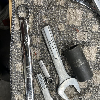97Sandbox
Elite Explorer
- Joined
- February 7, 2019
- Messages
- 1,103
- Reaction score
- 998
- City, State
- Seward, NE
- Year, Model & Trim Level
- 2000 Explorer Sport
That sounds like how the main negative is ran on 4.0 trucks (at least the two I've owned) except they run the cable to the bottom starter bolt (4.0 OHV below).On the 1960's Ford Mustangs, we have been removing the negative cable from the block then installing directly from the battery to the top starter bolts. It's a simple set-up but takes out the way low stock ground spot issues.
I wonder why the 5.0 main negative cable runs to the timing cover. I bet I could swap in a spare V6 negative cable I have if I really wanted to bypass the stock one on the Mounty.










